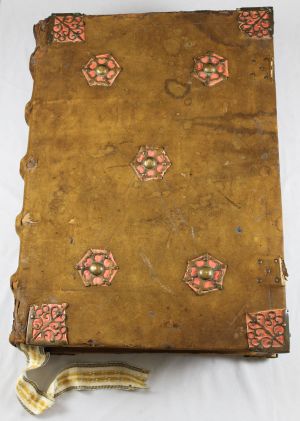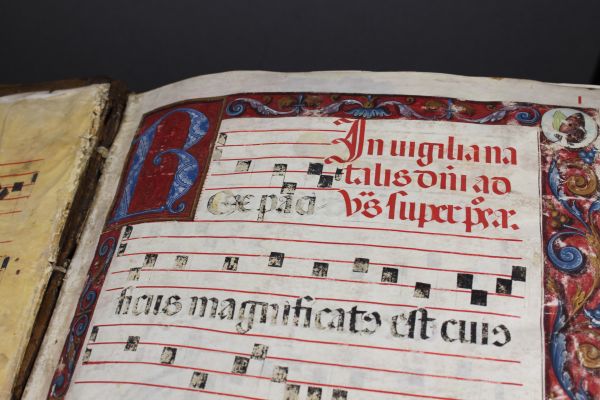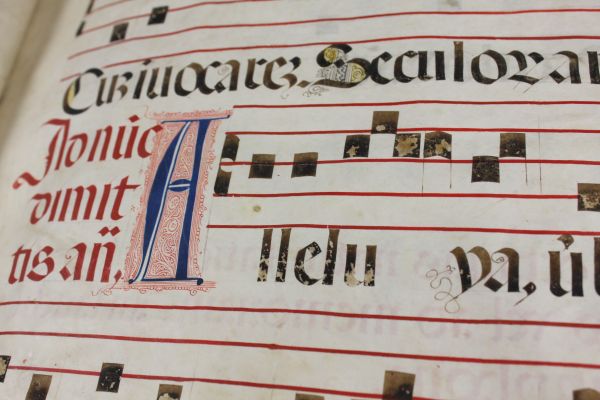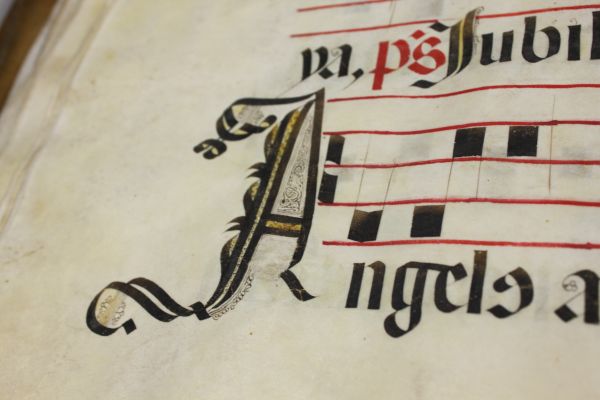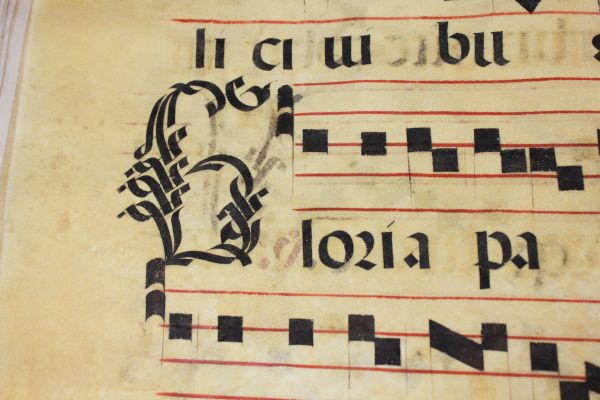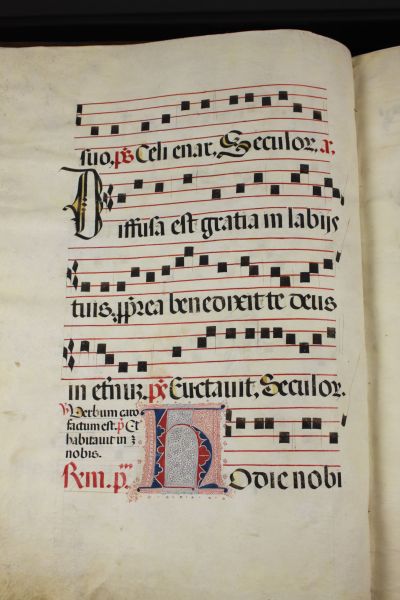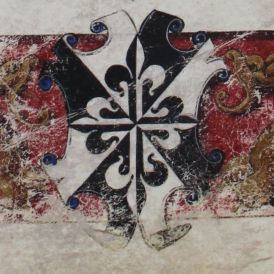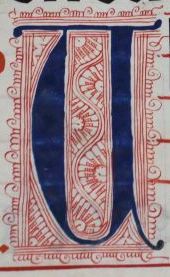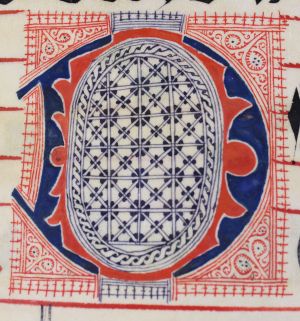University Libraries
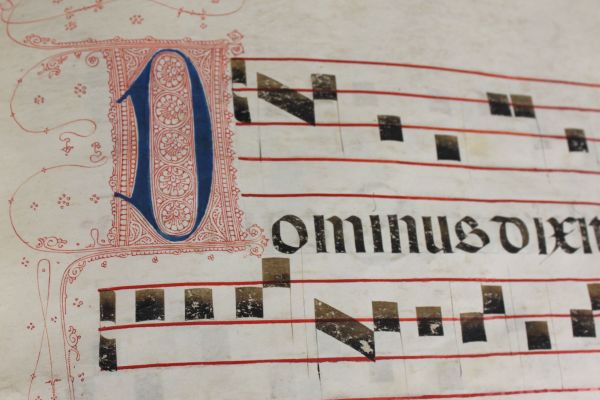
The Mystery of the Spanish Antiphonary
By Maureen Schlangen
As Christians worldwide spend Advent in anticipation of the commemoration of the Nativity of Christ, archivists, theologians and rare-book enthusiasts in the University Libraries have been relishing some new realizations about a really old Christmas book.
The sturdy volume, thought to be mid-15th century from a Spanish monastery, contains 484 vellum pages of mostly Christmastide antiphons — sung or chanted verses used in liturgy. This fall, the book, an antiphonary for the Liturgy of the Hours, formerly called the Divine Office, became a topic of fascination and conversation — as well as some speculation — when University archivist Jennifer Brancato asked Joan Milligan, a special collections cataloger with training in the cataloging of rare books, to create a detailed description of it.
When Milligan and colleague Scott West, an information resources specialist and medieval historian, joined Brancato in the rare book reading room to view it, the calligraphy and hand-colored illuminations captivated them along with the book’s metal adornments and other details.
An article so rich in artistic, cultural and religious expression warrants a description that conveys not only its nature, dimensions, contents and construction, but also its origin, its age, its creators and its purpose — some of which aren’t explicit, Milligan said. So in addition to being an antiphonary, it’s somewhat of a mystery. As it happens, though, the University Libraries are sort of “varsity” when it comes to religious artifacts from the Middle Ages and the Renaissance.
Clues, surprises ... and a centuries-old scrawl
Milligan invited about a half-dozen Marian Library and International Marian Research Institute faculty and staff to stop by and give input. To them, seeing it was like … well ... Christmas morning. With each new observation came a new delight.
Father Thomas Thompson, S.M., former director of the Marian Library and a specialist in liturgical music, and Jason Bourgeois, a librarian and theologian, paged through it, translating bits of Latin and noting the subjects of the antiphons, which begin with the feast of Christmas and continue through the fourth Sunday after Epiphany.
Noticing that the order was not consistent with that of the Roman Rite set at the Council of Trent (1545‒1563), they posited that the book was pre-Tridentine.
The book — 58 centimeters tall with large Gothic script and plainsong notation — would have been used in a monastery, they said. Father Simon Mary Maroney, a Carmelite monk and an IMRI student, spied a Dominican cross in the ornate illustration on the first page, which may mean the prayers’ sequencing is in accordance with that order’s rites.
A small, faint note attached inside the cover’s front board appears to be in Spanish. Unsourced notes kept with the book had identified it as Spanish, and Brancato has since located a 1958 auction catalog description that supports this.
The binding and cover do not offer strong clues about the book's age, said Sarah Burke Cahalan, director of the Marian Library. While the style appears to be contemporary, it is likely that the current cover was added later. She said it does not look truly medieval, but rather what the post-medieval world thinks medieval should look like.
The inclusion of antiphons for additional feasts may yet help further specify the manuscript’s origin and age. Religious orders often include devotions of particular interest to them. This antiphonary includes the feast of St. Vincent of Saragossa, the first Spanish martyr (Jan. 22). It also includes songs for the feasts of St. Agnes (Jan. 21) and St. Gabriel the Archangel (celebrated at various times in the past on March 18, a week before the Annunciation, and March 24, a day before). The inclusion of St. Gabriel's feast, coming so long after Epiphany, is one of the mysteries remaining.
“Although I am not a liturgist, I think that in the past there may have been a celebration of the Annunciation during Advent,” said Gloria Dodd, interim director of the International Marian Research Institute. “If so, and if that was for specific years, that may help to provide a date.”
still searching
Research will continue. Brother Andrew Kosmowski, S.M., referred Brancato to a Dominican friend in Cincinnati who may have some insights. Brancato has extended an invitation, and in the coming year, she plans to invite more visiting IMRI scholars and University faculty to see it and share their expertise.
As they wait for more clues to emerge, Brancato and Milligan can take to heart the timeless words of Christ in Luke 8:17: “For there is nothing hidden that will not become visible, and nothing secret that will not be known and come to light.”
A modern use for the late medieval material
- Music and musicology professor Samuel Dorf has been bringing his students to sing from the antiphonary since 2010, his first year on the faculty. That fall, he’d been in the University Archives exploring the Zimmerman Collection of instruments from around the world when Roesch Library special collections curator Nicoletta Hary, who died Oct. 4, 2017, asked if he would like to see the antiphonary. Once he saw it, a field trip was in order. University of Dayton Magazine editor Michelle Tedford documented it in a 2010 blog.
— Maureen Schlangen is e-scholarship and communications manager in the University Libraries.

